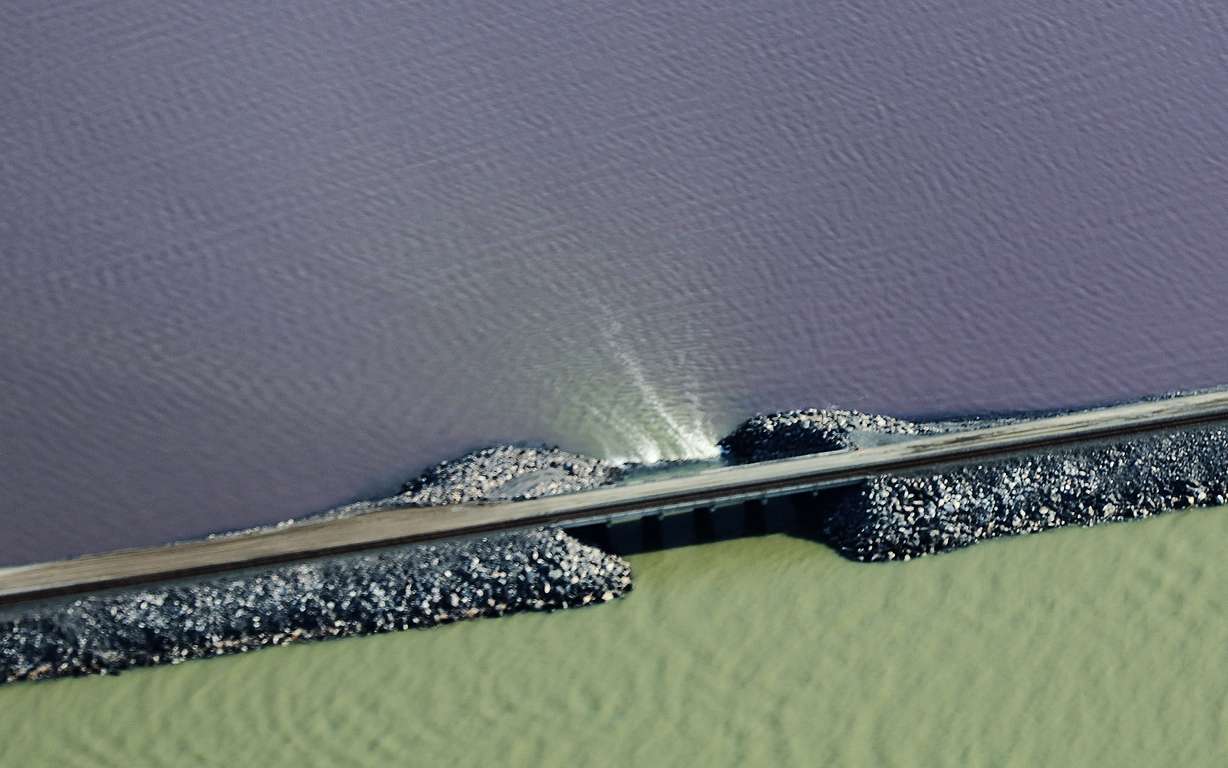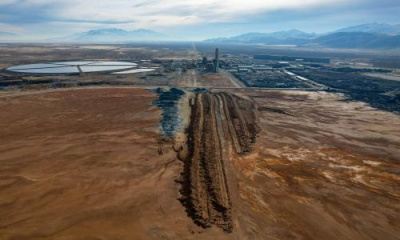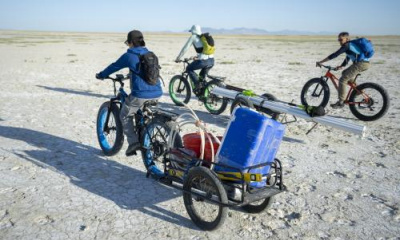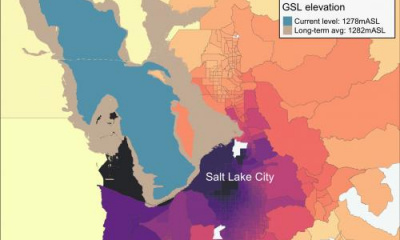SALT LAKE CITY — Kevin Perry isn't completely surprised by this year's record snowpack.
Utah's snowpack, a measure of the water contained within the snow that falls in the mountains, reached 30 inches statewide this year for the first time since the Natural Resources Conservation Service began calculating the number in the 1930s. There's actually more than 40 inches at two of the three basins that feed the tributaries that dump into the Great Salt Lake.
Perry, a professor of atmospheric sciences at the University of Utah, explains that about every 12 or 13 years, there's a major precipitation spike — seemingly out of the blue. It happened in 2011 and 1997, as well as that remarkable run between 1982 and 1984.
"That's due to circulation patterns in the ocean," he says. "Most of the time, we get this one big year and it only lasts one year. Occasionally, we'll get two years out of it."
This year's wintery onslaught couldn't have come at a better time for the Great Salt Lake, though, which fell to its lowest level on record for the second-straight year in 2022. The levels recorded at the U.S. Geological Survey's Saltair Boat Harbor site had dipped to 4,188.7 feet elevation by November.
It's now back to 4,192.7 feet, as of Thursday morning, gaining 4 feet since hitting that record low. The lake's recent recovery, however, is actually a mixture of natural and man-made factors.
The primary reason is, of course, the record snowpack melting is feeding into the Great Salt Lake. It helps that multiple water management agencies, such as the Central Utah Water Conservancy District and Salt Lake City Department of Public Utilities, are sending more water to the lake than usual to avoid flooding concerns in the valleys.
But also, the Utah Division of Forestry, Fire and State Lands raised its berm at the Union Pacific Railroad causeway to divide the lake in an effort to control salinity levels in its southern arm and allow it to fill up faster. Now that the arm's levels are beginning to exceed the berm's height, Perry said the lake's recovery will likely slow down a bit since the incoming water will fill the whole lake and not just one of its halves in the coming weeks and months.
"I still suspect that we're going to get another 2 to 2½ feet out of the snowpack melting, so that will put us up to about 4,195 (feet), something like that, at the end of the spring," he said.
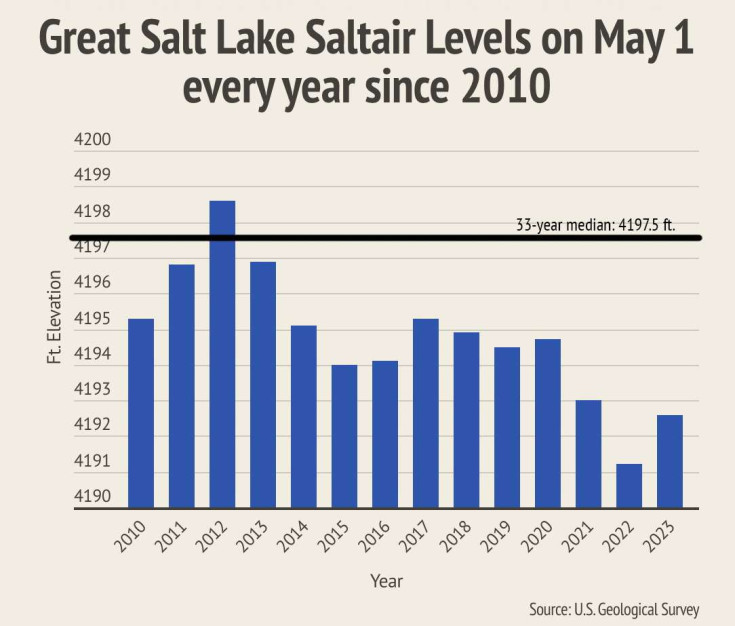
This graphic shows the final level recorded at the Great Salt Lake Saltair Boat Harbor station on May 1 over the past 13 years along with the station's 33-year median level. (Photo: KSL.com)
It's a huge development but it doesn't change the lake's long-term outlook, adds Perry, one of the lake's leading researchers. This winter's remarkable snowpack instead offers a few more years before the lake's ecosystem potentially collapses, unless drastic changes are made in the state's water consumption habits.
The lake's long-term outlook
Dozens of researchers warned the lake "as we know it, is on track to disappear in five years," in a damning report released in January. The team singled out excessive water consumption as the leading culprit, as the lake has lost 73% of its water and 60% of its surface area since 1850.
Perry isn't one of the report's many authors but he also believes many people misinterpreted this study when it was first released. He explains that, yes, it would still be a Great Salt Lake in five years; however, if water consumption trends continued without much change, it wouldn't be recognizable anymore.
"It will be dead," he said, pointing out that salinity levels were already on the brink of killing off brine shrimp at the time the report was released. "The salinity would be so high (that) the brine shrimp and brine flies will all be gone and the birds will all be starving."
So how did this year's record snowpack and spring runoff impact the lake's future?
Salinity levels fell from 19% to about 16%, a high percentage but within the brine shrimps' tolerable range, Perry says. The raised berm likely saved the lake's ecosystem from falling apart early.
He also estimates that this year likely adds two years to the report's findings, based on the runoff that has already happened and what's likely to come this year. When taking into account the typical summer loss, he projects that the lake will be about 4,192.5 feet to 4,193 feet by the end of the year, close to current levels.
"What that has done is that it's reset the clock on the five years," he said. "This wonderful snowpack has bought us 2 to 2½ more years or so in order to help our conservation measure actually start to kick in, so we can start using less water so we can put more water in the lake."
Ben Abbott, assistant professor of ecosystem ecology at BYU and one of the study's researchers, said he agrees with Perry's assessment, calling this year's snowpack a "short-term windfall."
The reason that it isn't longer is that the lake's drop was so significant during the most recent drought that ravaged Utah. So, even with the massive gains happening this year, the projected level at the end of the year mirrors levels recorded at the end of 2020 and the spring of 2021.
In addition, both this year's outlook and the spring 2021 levels are well below May 1 levels over the past decade and the lake's overall 33-year median level, per U.S. Geological Survey data.
And while the current drought continues to ease up as a result of the record winter, the West remains in the grips of a megadrought, a series of droughts over the past two decades. It may last another decade based on the studies of other megadroughts in the past, Perry asserts.
If there is a normal snowpack again next winter, which is entirely possible because of the circulation pattern, drier conditions are more likely to return in the years that follow, much like what happened after 2011.
In short, this is why researchers say the Great Salt Lake remains in trouble despite the prolific winter.
Preserving the lake, reducing consumption
It's also why state and local leaders haven't changed their water use messaging as warmer temperatures return.
Salt Lake City Mayor Erin Mendenhall referenced Perry's work as she unveiled her proposed 2024 fiscal year budget to the Salt Lake City Council on Tuesday. Her plan includes a new Great Salt Lake Shoreline Preservation area, in coordination with several groups, including the Audubon Society and the Center for Biological Diversity.
"Our namesake's well-being and long-term viability (are) still critical and urgent," she said.
New water conservation efforts are also underway for the first time since the report came out. In addition to the new preserve, Mendenhall called on the council earlier this year to approve a plan to send about 13 billion gallons of reclamation water directly to the Great Salt Lake every year. It's unclear when that will begin.
Meanwhile, Utah Gov. Spencer Cox rolled out a new statewide turf grass-buyback program this week, which has the potential to cut back on how much municipal water is used on lawns. The state estimates that about 60% of all municipal water is used for outdoor irrigation.
At the same time, the Utah Legislature added $200 million to the state's agriculture optimization program, assisting farmers and ranchers as they look for more efficient ways to use their water. It's estimated that agricultural irrigation accounts for between 75% and 85% of all Utah's water consumption. The state's water leasing plan is expected to take off this year, as well.
These efforts, Perry says, have the potential to provide more water for the Great Salt Lake. He is a part of the strike team that released a different report in February finding Utahns use about 30% beyond the normal water runoff, which is a key reason for the lake's decline especially during the megadrought.
The report also found water optimization and water leasing programs, where water rights owners temporarily lease their rights so the water flows into the lake, are the most efficient and feasible ways to get water to the lake, likely cutting into that 30% figure. But the lake's future depends heavily on those programs and other water cutbacks to take effect and work.
Until then, Utah will need more above-normal snowpack years to get water into the lake.
"Even if we have a normal snowpack next year, if we use the same amount of water we've been using, the lake will shrink again next year," he said. "Don't be fooled by this one big year. We're still in this dry period."

